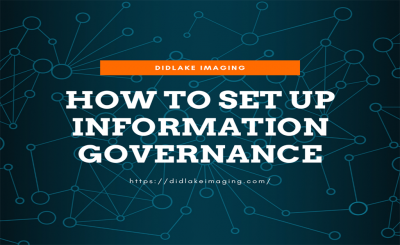
Most business directors and senior officials take their corporate governance very seriously. Information governance is a subset of corporate governance and should be taken just as seriously.
With constantly evolving regulatory, legal, risk, and operational requirements, company decision makers need to correctly set up information governance to support positive business outcomes, but what does the set up process entail?
What Is Data and Information Governance?
Information governance is the strategic framework organizations use to process and manage data at an organizational level. The process is strategic to organization objectives and focuses on a top-down approach to maximize data value and minimize risks. For organizations in possession of sensitive patient and medical records, or financial statements, setting up information governance is essential.
Maintaining common document retention policies and other regulatory compliances is legally required for companies who handle and store personal information in print and digital form. While many privacy and security standards evolve at scale each year, information governance concepts are consistent. Information governance frameworks ensure personal information is handled with legal and ethical obligations in mind.
Why is Information Governance Important?
Information governance poses operational burdens for businesses as the amount of data we produce increases. Estimates suggest that most companies’ unstructured data grows by approximately 80% each year. Data and information overload will only increase in the coming years as information governance laws and regulations put stricter mandates on personally identifiable information.
Manually processing unstructured data to retain and dispose of poses challenges for organizations relying on outdated record management systems such as microfiche. Inadequate management of records stored across different file management systems poses security breaches and risks. Organizations use a diverse array of networks and systems to share information. Paper documents and unstructured data can limit the shared, stored, distributed, and preserved.
What are the Key Concepts of Information Governance?
Information governance covers all information, regardless of format. Data can be stored in databases and unstructured formats such as email and documents. Information is everywhere, stored in various computing formats and paper files. Information governance uses the following key concepts to create the best value and benefits for organizations:
- Cybersecurity
- Privacy
- Records Management
- Data Analytics
- Information Management
- eDiscovery
- Data Governance
- Risk & Compliance
Using these key concepts of information governance can decrease regulatory and legal risks, increase employee efficiency, and provide solutions for common business challenges.
What Goals Does Information Governance Achieve?
Information governance aims to break down silos and avoid fragmentation of information. It ensures that the organization remains trustworthy in the processes, technology, and people they use to manage information.
The strategic approach sets critical goals for your organization that include:
- Promoting the value of data assets
- Resolving data related issues and creating processes to prevent them in the future
- Enforce organizational conformance to standards and policies
- Clear communication of data policies, standards, and procedures
- Tracking, approval, and overseeing of the delivery of sensitive documents and data
Who Needs Information Governance?
Companies who want to remain competitive need information governance. Before the rise of the global digital economy, business information was traditionally managed by different disciplines within an organization. The compliance team would handle regulatory challenges, while the cybersecurity team manages the systems and tools that encrypt and protect data.
Today, information governance is an umbrella concept that describes all information management activities. Forward-thinking and innovative companies are opting for a collective approach to managing their information. The process unites organization disciplines and provides a strategic focus on the value and cost of data.
The Information Governance Framework
Each organization defines its own information governance frameworks to formally outline its goals and processes. The framework answers all the who, what, where, when, how, and why questions on what unique business requirements are addressed.
The Scope
The scope of your information governance framework establishes the extent of your organization’s program. It provides a clear outline of goals, the type of data your organization manages, and which staff members are involved.
Policies and Procedures
Information governance frameworks also define the corporate policies and procedures that guide the program. This includes all data security, document retention policies, disposal schedules, information sharing policies, and privacy standards.
Roles and Responsibilities
The framework you create should define the specific departments and employees who are responsible for essential functions of information governance. Responsibilities are given to individuals who will play a role in your organization’s information governance integration and implementation.
Internal and External Data Management
The most important aspect of the information governance framework is how the organization manages internal and external data management. This section of the framework should include the legal and regulatory compliances, content types, sharing, archival, and storage processes for personal and sensitive information.
Steps to Implementing An Information Governance Plan
Since information governance programs are a holistic and organization wide initiative, top-level sponsorships and consistent approaches are needed for successful implementation. Here are a few tips to make information governance implementation successful.
#1: Start the Process Now
There’s no time like the present to start tackling your business’s information governance. Most organizations have to adhere to multiple regulations, and it’s likely yours does as well. Fewer than one in three organizations have confidence that their retention policies could stand up to regulatory scrutiny.
All businesses should have a document retention policy and schedule. Before setting up your information governance, make sure your records retention schedule is tailored to your organization, user-friendly, and all employees are trained to use it.
#2: Get All Stakeholders on Board
It’s a good idea to assign one person to take the lead on information governance for your organization. But you will need buy-in from executives and other stakeholders across your company to be successful.
You will need to reach out to the following stakeholders before implementation:
- Executives
- Legal
- HR and Finance
- IT and Security
- End users
When approaching stakeholders about information governance, be sure to know your audience. You need to be able to bring together leadership by demonstrating results that support organizational initiatives.
#3: Create Organizational Document Lifecycle Management
Protect your company’s sensitive data by applying strict policies that will follow your content. You can set guidelines for your employees to make it easy for them to adhere to governance requirements. This can be done by creating specific classification levels, specific time periods for retention, deletion of records, and creating rules for external sharing.
Without a proper document lifecycle management process, keeping track of records across different file management systems is difficult. Keeping track of data and managing access permissions is easier when information governance is combined with an automated document imaging system. Automating document approvals, access, and disposal is a robust and adaptable frame to keep your assets governed and protected.
#4: Keep the Process Simple
Don’t get trapped in the analysis paralysis before implementing your information governance plan. Instead, work with your stakeholders to apply appropriate policies to as much content as possible, especially your high-risk or regulated data.
Setting up information governance gives organizations significant benefits and value, especially as the amount of data we collect and store grows with increased regulatory oversight. Developing and implementing a sound information governance strategy helps ensure your data is available to the right people with minimized risks and increased access control.
Before your organization suffers a security breach, faces a lawsuit, or fails an audit, create an information governance framework that protects your reputation and data.
Didlake Imaging provides comprehensive digital document management services that help enhance your information governance framework. Request a free quote from our team to get your information protected.







